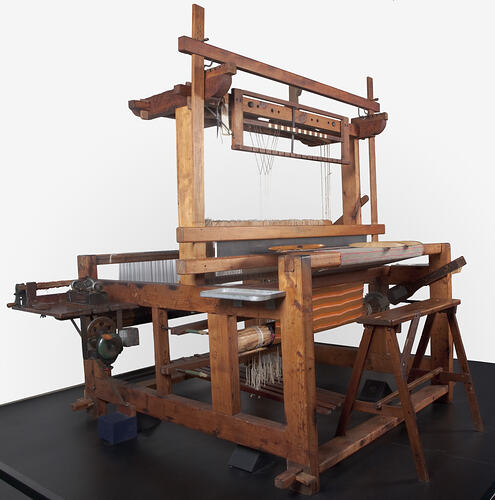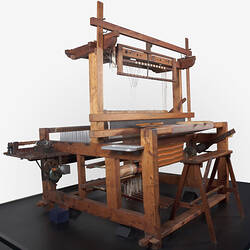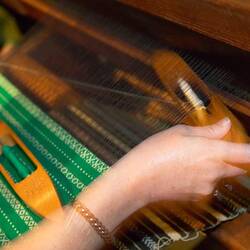Summary
Seat for the countermarch floor loom made for Anna Apinis by fellow survivors of World War II, in Memmingen, a displaced persons camp in Germany with wood scavenged from bombed-out ruins, circa 1945. The loom and this seat was designed by Anna's husband Ervins. Anna used the loom to weave traditional Latvian designs using threads gathered by unravelling old scraps of fabric. Anna brought the loom with her to Australia and continued to weave Latvian designs on it, both traditional and experimental. She also taught her daughter Anita to weave on this loom. She became one of the few suppliers of fabric for Latvian national costumes in Australia in the 1950s and 1960s, and exhibited her weaving nationally, at exhibitions and Latvian cultural festivals. Anna fulfilled her dream to keep her cultural traditions alive through her daughter Anita who continues to weave to this day.
Physical Description
Wooden seat, with four turned wooden legs and a rectangular piece of wood for the seat.
Significance
Significance: These items form part of the Apinis Latvian weaving collection, a collection of Latvian weavings, tools (including a countermarch floor loom), weaving notebooks, costume items and audio visual interviews. Its historical and cultural significance lies in the comprehensive documentation of the story through artefacts and narratives, the quality of the weavings and the rarity of particular items such as the loom created in a German displaced persons' camp after World War II and notebooks kept from the 1930s to preserve traditional Latvian weaving techniques. The collection documents the maintenance and transportation of cultural traditions.
More Information
-
Collection Names
-
Collecting Areas
-
Acquisition Information
Donation from Mrs Anita Apinis-Herman, Jun 2010
-
Designer
-
User
-
User
-
User
-
Classification
-
Category
-
Discipline
-
Type of item
-
Keywords
Brought Goods, Cultural Maintenance, Cultural Traditions, Displaced Persons, Latvian Communities, Latvian Immigration, Looms, Making Do, Weaving, Woodworking, Refugees, Displaced Persons Camps



